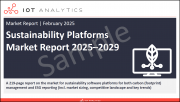
|
시장보고서
상품코드
1651181
지속가능성 플랫폼 시장(2025-2029년)Sustainability Platforms Market Report 2025-2029 |
||||||
본 보고서는 지속가능성 플랫폼 시장을 조사했으며, 시장 정의, 성장 촉진요인 및 과제, 시장 규모 추이 및 예측, 경쟁 구도, 주요 동향 및 전개, 사례 연구 등을 정리하여 전해드립니다.
SAMPLE VIEW



SAMPLE VIEW


시장 정보
지속가능성 플랫폼 시장은 아직 개발 초기 단계에 있지만, 빠르게 성장하고 있습니다. 대부분의 도입 기업들은 아직 파일럿 단계나 소규모 도입에 머물러 있습니다. 이 시장은 8가지 주요 벤더 유형으로 고도로 세분화되어 있습니다. 벤더는 8개의 부문으로 분류됩니다.
|
|
SAMPLE VIEW


주요 시장 성장 촉진요인 및 과제, 동향
IoT Analytics는 5가지 촉진요인과 7가지 과제를 확인했습니다.
지속가능성 플랫폼이란?

정의
지속가능성 플랫폼은 조직이 지속가능성 성과를 이해하고, 관리하고, 개선할 수 있도록 설계된 소프트웨어 도구입니다. 지속가능성 플랫폼은 ESG의 다양한 측면에 걸친 지속가능성 관련 데이터의 수집, 집계, 분석 및 보고를 간소화하여 조직의 지속가능성 성과를 전체적으로 파악할 수 있도록 돕습니다.
분류
|
|
|
SAMPLE VIEW


주요 특징
지속가능성 플랫폼의 가장 중요한 특징은 다음 세 가지입니다:
- 1. 첨단 분석 : 이 플랫폼은 강력한 분석을 통해 주요 지속가능성 지표, 트렌드, 개선이 필요한 영역에 대한 통찰력을 제공하여 데이터 기반 의사결정을 지원합니다.
- 2. 보고서 기능 : 자동화된 도구를 사용하여 ESG 표준 준수를 간소화하고 내부 및 외부 보고 프로세스를 간소화 할 수 있습니다.
- 3. 협업 툴 : 이러한 도구는 피드백 시스템, 공유 대시보드, 통합 워크플로우를 통해 이해관계자 간의 소통과 참여를 촉진합니다.
주요 장점
지속가능성 플랫폼의 가장 가치 있는 장점은 다음 세 가지입니다:
- 1. 규제 준수 용이화 : ESG 데이터 관리 및 보고를 자동화함으로써 기업은 진화하는 규제 요건에 부합할 수 있습니다.
- 2. 의사결정 개선 : 데이터에 기반한 통찰력을 통해 기업은 위험과 기회를 파악하고, 자원 사용을 최적화하고 비용을 절감하는 전략을 추진 할 수 있습니다.
- 3. 투명성과 이해관계자의 관여 : 명확하고 접근하기 쉬운 정보를 제공함으로써 이해관계자와의 신뢰를 쌓고 책임감 있는 행동에 대한 약속을 보여줌으로써 조직의 평판을 높일 수 있습니다.
답변된 질문
- 지속가능성 플랫폼이란?
- 지속가능성 플랫폼의 주요 특징과 기능은 무엇인가?
- 지속가능성 플랫폼의 주요 공급업체는 어디인가?
- 지속가능성 플랫폼 시장 규모는 어느 정도이며, 부문(지역 및 산업별)로 어떻게 나뉘는가?
- 지속가능성 플랫폼을 도입한 기업의 사례는 어떤 것이 있는가?
- ESG 보고는 어떻게 작동하는가?
- 정부와 기업의 지속가능성 목표에는 어떤 것들이 있는가?
- 지속가능성이란 무엇인가?
- 시장의 주요 동인 및 동향은 무엇인가?
- 지속가능경영 플랫폼 도입의 주요 과제는?
게재기업
|
|
목차
제1장 주요 요약
제2장 지속가능성 : 서론
- 본 장의 개요와 중요 포인트
- 출발점 : 지속가능성은 인류에게 있어서 최대 과제
- 최근 '지속가능성'과 '기후'에 대한 국민과 기업 의식은 함께 높아지고 있다
- 1) 지속가능성과 2) 지속가능한 개발 정의
- 지속가능성의 3개 핵심적 측면 : 고전적인 지속가능성 모델
- '보다 강력한' 지속가능성 모델은 환경을 제일로 생각한다
- 세계의 지속가능한 개발 대처 진화의 중요 마일스톤
- 환경 지속가능성의 6개 주요 측면
- 1. 온실가스
- 2. 정책 : 유엔 지속가능한 개발 목표
- 3. 순환형 경제
- 4. 삼림 파괴
- 5. 에너지 사용
- 6. 오염
- 지속가능성을 높이는 방법 : 애널리스트 주요 견해
제3장 탄소발자국과 관리
- 본 장의 개요와 중요 포인트
- 탄소발자국이란 무엇인가?
- 탄소중립과 넷 제로의 차이
- 탄소발자국 계산을 위한 세가지 온실가스 배출 범위
- 기업이 이산화탄소 배출량을 감축하는 3가지 주요 방법
- 탄소 가격
- 현황 : 세계 각국의 탄소 가격 책정 이니셔티브 개요
- ETS와 탄소세 실례
- 현황 : 현재의 ETS와 탄소세 가격 동향
- 지속가능한 개발 개발 기타 10개 일반 용어
제4장 기업과 정부 이산화탄소 배출 목표
- 본 장의 개요와 중요 포인트
- 현황 : 주요 국가 정부의 지속가능성 목표
- 현황 : 주요 도시의 지속가능성 목표
- 현황 : 대기업의 지속가능성 목표
- 예 1 : Microsoft
- 예 2 : Apple
- 예 3 : Siemens
제5장 ESG 리포팅 : 기준, 프레임워크, KPI
- 본 장의 개요와 중요 포인트
- 환경, 사회, 거버넌스에 관한 보고와 그 3가지 측면
- ESG 리포팅의 역할
- ESG와 지속가능성의 차이
- ESG 데이터 검증과 보증
- ESG 리포팅 베스트 프랙티스
- ESG 기준과 프레임워크 이해
- 4개 주요 ESG 표준화 단체
- SBTi(The Science Based Targets initiative)
- ESG 규제
- ESG 규제 : 지역별 개요
- ESG 리포팅의 진화 : 글로벌 표준
- ESG KPI : 정의와 역할
- 일반적 ESG 지표 개요
- 환경 지표 : 설명과 일반적 KPI
- 소셜 시학 : 설명과 일반적 KPI
- 거버넌스 지표 : 설명과 일반적 KPI
- 표준화된 ESG 지표 예 #1 : 이해관계자의 자본주의 지표
- 표준화된 ESG 지표 예 #2 : 첨단 제조업
- 표준화된 ESG 지표 예 #3 : 모바일 업계
- 표준화 된 ESG 지표 예 #4 : 제조업
제6장 지속가능성 플랫폼의 정의
- 본 장의 개요와 중요 포인트
- 지속가능성 플랫폼이란 무엇인가?
- 지속가능성 플랫폼의 8개 주요 특징
- 지속가능성 관리 솔루션의 3개 주요 카테고리
- 탄소 관리 플랫폼
- ESG 관리 및 보고 플랫폼
- 공급망 지속가능성 플랫폼
- 지속가능성 플랫폼의 8개 주요 이점
- 3개 주요 가격 모델
제7장 시장 규모와 전망
- 본 장의 개요와 중요 포인트
- 이 시장 규모의 초점 영역
- 세계의 지속가능성 플랫폼 시장 추이·예측
- 지속가능성 플랫폼 시장 : 벤더 점유율
- 세계의 지속가능성 플랫폼 시장 : 지역별
- 세계의 지속가능성 플랫폼 시장 : 북미
- 세계의 지속가능성 플랫폼 시장 : 유럽
- 세계의 지속가능성 플랫폼 시장 : 아시아태평양
- 세계의 지속가능성 플랫폼 시장 : 라틴아메리카
- 세계의 지속가능성 플랫폼 시장 : 중동 및 아프리카
- 세계의 지속가능성 플랫폼 시장 : 러시아 및 CIS
- 세계의 지속가능성 플랫폼 시장 : 가장 큰 국가
- 세계의 지속가능성 플랫폼 시장 : 업계별
- 세계의 지속가능성 플랫폼 시장 : 고객 규모별
- 세계의 지속가능성 플랫폼 시장 : 소프트웨어 유형별
제8장 경쟁 구도
- 본 장의 개요 및 중요 포인트
- 벤더 구도 : 솔루션 초점별
- 벤더 구도 : 기업 중점 분야별
- 벤더 구도 : 기업 소재지별
- 벤더 구도 : 기업 규모별
- 과거 3년간 SP 기업의 주목해야 할 인수
- 벤더 구도 : 스타트업
- 가장 자금 제공을 받은 SP 스타트업
- 기업 개요 : 개요
- 벤더 개요 : Microsoft
- 벤더 개요 : SAP
- 벤더 개요 : Salesforce
- 벤더 개요 : IBM
- 벤더 개요 : Sphera
- 벤더 개요 : Persefoni
- 벤더 개요 : Wolters Kluwer
- 벤더 개요 : Workiva
- 벤더 개요 : Watershed
- 벤더 개요 : Sweep
- 벤더 개요 : ServiceNow
- 벤더 개요 : Cority
- 벤더 개요 : Schneider Electric
- 벤더 개요 : Siemens
제9장 성장 촉진요인, 과제 및 동향
- 본 장의 개요와 중요 포인트
- 성장 촉진요인
- 과제
- 동향
제10장 조사 방법
제11장 IoT Analytics에 대해
LSH 25.02.28A 219-page report on the market for sustainability software platforms for both carbon (footprint) management and ESG reporting (incl. market sizing, competitive landscape and key trends)
The "Sustainability Platforms Market Report 2025-2029" is part of IoT Analytics' ongoing coverage of emerging technology topics and vertical applications. The information presented in this report is based on the results of multiple surveys, secondary research as well as qualitative research, i.e., interviews with industry experts from vendors and end users. The document includes definitions for sustainability platforms, market projections, adoption drivers, competitive landscape, key trends and developments, and case studies.
SAMPLE VIEW

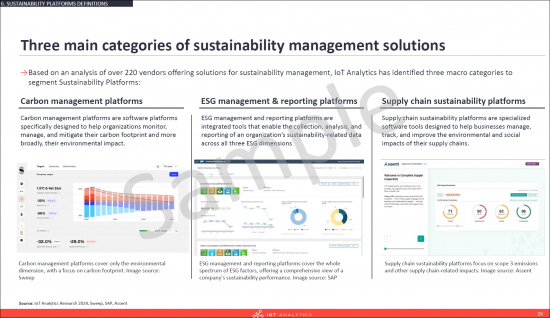

The main purpose of this document is to help our readers understand the current sustainability platform landscape by defining, sizing, and analyzing the market.
SAMPLE VIEW
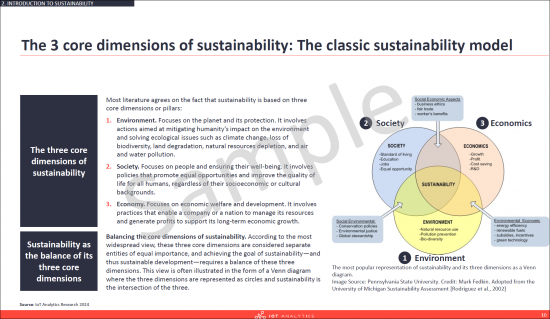
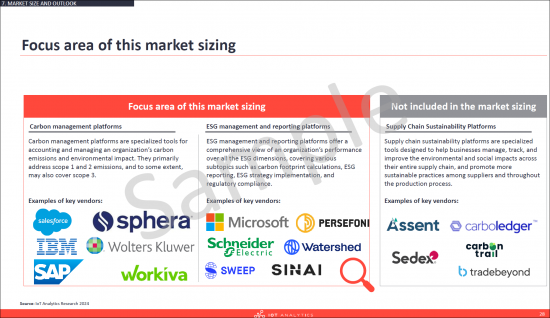
About the market
The sustainability platform market is still at an early stage of development but growing rapidly. Most adopters are still at the pilot stage and/or with small-scale implementations. It is highly fragmented with eight main vendor types. Vendors are categorized into 8 segments:
|
|
SAMPLE VIEW
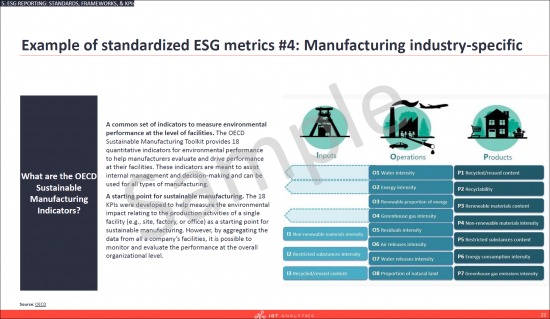
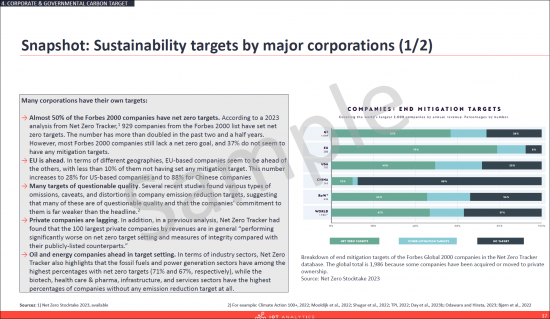
Key market drivers, challenges, and trends
IoT Analytics identified 5 drivers and 7 challenges highlighted in the report.
What are sustainability platforms?
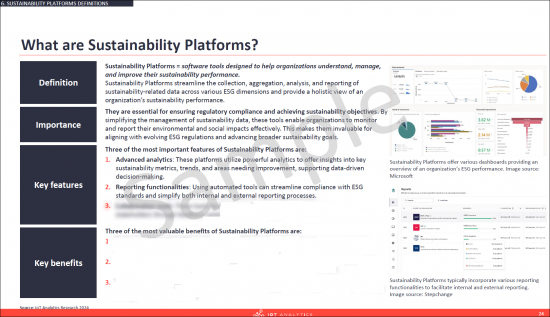
Definition
Sustainability Platforms are software tools designed to help organizations understand, manage, and improve their sustainability performance. Sustainability Platforms streamline the collection, aggregation, analysis, and reporting of sustainability-related data across various ESG dimensions and provide a holistic view of an organization's sustainability performance.
Categorization
|
|
|
SAMPLE VIEW
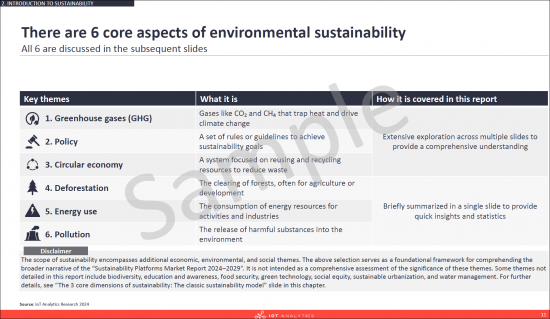
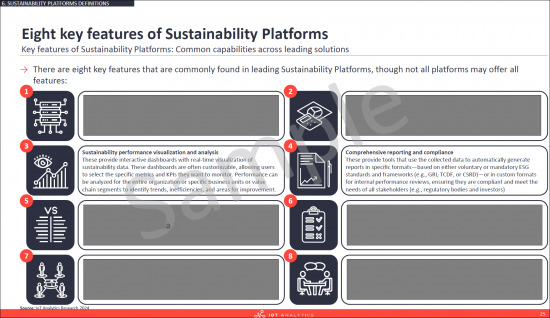
Key features
Three of the most important features of Sustainability Platforms are:
- 1. Advanced analytics: These platforms utilize powerful analytics to offer insights into key sustainability metrics, trends, and areas needing improvement, supporting data-driven decision-making.
- 2. Reporting functionalities: Using automated tools can streamline compliance with ESG standards and simplify both internal and external reporting processes.
- 3. Collaboration tools: These tools facilitate communication and engagement among stakeholders through feedback systems, shared dashboards, and integrated workflows.
Key benefits
Three of the most valuable benefits of Sustainability Platforms are:
- 1. Easier regulatory compliance: Automating ESG data management and reporting ensures organizations stay aligned with evolving regulatory requirements.
- 2. Improved decision-making: Data-driven insights enable organizations to identify risks and opportunities, driving strategies that optimize resource use and reduce costs.
- 3. Transparency and stakeholder engagement: Providing clear, accessible information builds trust with stakeholders and demonstrates a commitment to responsible practices, enhancing an organization's reputation.
Questions answered:
- What are sustainability platforms (i.e., a definition)?
- What are the key features and capabilities of sustainability platforms, both for ESG reporting and for carbon management?
- Who are the leading vendors of sustainability platforms, and how much market share do they have?
- How large is the sustainability platforms market, and how does it split into segments (i.e., by regions or industries)?
- What are some insightful case studies of companies implementing sustainability platforms?
- How does ESG reporting work?
- What are some of the sustainability targets of governments and selected corporations?
- What is sustainability, and what are its various aspects?
- What are the key drivers and trends in the market?
- What are the key challenges to sustainability management platform adoption?
Companies mentioned:
A selection of companies mentioned in the report.
|
|
Table of Contents
1. Executive Summary
2. Introduction to sustainability
- Introduction to sustainability: Chapter overview and key takeaways
- Starting point: Becoming sustainable is a top challenge for humanity
- Both public and corporate awareness of "sustainability" and "climate" have jumped in recent years
- Defining 1) sustainability and 2) sustainable development
- The 3 core dimensions of sustainability: The classic sustainability model
- The "stronger" sustainability model puts the environment first
- Key milestones in the evolution of global sustainable development efforts
- There are 6 core aspects of environmental sustainability
- 1. Greenhouse gases: Overview
- 1. Greenhouse gases: What they are
- 1. Greenhouse gases: The nine main types of gases
- 1. Greenhouse gases: Main contributors to GHG emissions
- 1. Greenhouse gases: Emissions by sector
- 1. Greenhouse gases: Fossil fuel company emissions
- 1. Greenhouse gases: The Greenhouse effect
- 1. Greenhouse gases: The effect on climate change
- 2. Policy: The UN Sustainable Development Goals
- 2. Policy: The UN Sustainable Development - goals
- 2. Policy: The UN Sustainable Development - current progress
- 2. Policy: The Paris Agreement - overview
- 2. Policy: The Paris Agreement - current status
- 3. Circular economy: Overview
- 3. Circular economy: Key benefits
- 3. Circular economy: Key challenges
- 3. Circular economy: The role of technology
- 3. Circular economy: Daisy helps Apple battle e-waste
- 3. Circular economy: Life cycle assessment
- 4. Deforestation
- 5. Energy use
- 6. Pollution
- How to become more sustainable: Key analyst viewpoints
3. Carbon footprint and management
- Carbon footprint and management: Chapter overview and key takeaways
- What is a carbon footprint?
- The difference between Carbon Neutral and Net Zero
- Three GHG emission scopes for carbon footprint calculations
- Three main ways for companies to reduce their carbon footprint
- Carbon pricing
- Snapshot: Overview of carbon pricing initiatives around the world
- Practical examples of ETS and carbon taxes
- Snapshot: Current ETS and Carbon Taxes pricing trends
- Ten other common sustainable development terms
4. Corporate and governmental carbon footprint targets
- Corporate and governmental carbon footprint targets: Chapter overview and key takeaways
- Snapshot: Sustainability targets by major governments
- Snapshot: Sustainability targets by major cities
- Snapshot: Sustainability targets by major corporations
- Example 1: Microsoft's commitment to sustainability
- Example 1: Microsoft's mission to become carbon negative by 2030
- Example 2: Apple's commitment to sustainability
- Example 2: Apple 2030-Apple's journey to carbon neutrality by 2030
- Example 3: Siemens' commitment to sustainability
5. ESG reporting: Standards, frameworks, KPIs
- ESG reporting - Standards, frameworks, & KPIs: Chapter overview and key takeaways
- Environment, social, and governance reporting and its three dimensions
- The role of ESG reporting
- The difference between ESG and sustainability
- ESG data verification and assurance
- Best practices for ESG reporting
- Understanding ESG standards and frameworks
- There are currently 4 major ESG standards organizations
- These are the four most commonly used ESG frameworks
- The Science Based Targets initiative (SBTi)
- ESG regulations
- ESG regulations: Regional overview
- Deep Dive: Two key ESG reporting regulations in EU and US
- The evolution of ESG reporting highlights the need for global standards
- ESG KPIs: Definition and role
- Overview of common ESG metrics
- Environmental metrics: Description and common KPIs
- Social metrics: Description and common KPIs
- Governance metrics: Description and common KPIs
- Example of standardized ESG metrics #1 : Stakeholder capitalism metrics
- Example of standardized ESG metrics #2: Advanced manufacturing-specific
- Example of standardized ESG metrics #3: Mobile industry-specific
- Example of standardized ESG metrics #4: Manufacturing industry-specific
6. Sustainability platforms definition
- Sustainability Platforms definitions & segmentation: Chapter overview and key takeaways
- What are Sustainability Platforms?
- Eight key features of Sustainability Platforms
- Three main categories of sustainability management solutions
- Carbon management platforms
- ESG management and reporting platforms
- Supply chain sustainability platforms
- Eight key benefits of Sustainability Platforms
- Three main pricing models
7. Market size and outlook
- Introduction: Chapter overview and key takeaways
- Focus area of this market sizing
- Global Sustainability Platforms Market 2022-2029
- Sustainability Platform market: Vendor shares 2023
- Global Sustainability Platform market: By region
- Global Sustainability Platform market: North America
- Global Sustainability Platform market: Europe
- Global Sustainability Platform market: Asia-Pacific
- Global Sustainability Platform market: Latin America
- Global Sustainability Platform market: Middle East & Africa
- Global Sustainability Platform market: Russia & CIS
- Global Sustainability Platform market: Largest countries
- Global Sustainability Platform market: By industry
- Global Sustainability Platform market: By customer size
- Global Sustainability Platform market: By software type
8. Competitive landscape
- Introduction: Chapter overview and key takeaways
- Vendor landscape: By solution focus
- Vendor landscape: By company focus
- Vendor landscape: By company location
- Vendor landscape: By company size
- Noticeable acquisitions of SP companies in the past 3 years
- Vendor landscape: Start-ups
- Most funded SP start-ups
- Company Profiles: Overview
- Vendor profile: Microsoft
- Vendor Profile: SAP
- Vendor Profile: Salesforce
- Vendor Profile: IBM
- Vendor Profile: Sphera
- Vendor Profile: Persefoni
- Vendor Profile: Wolters Kluwer
- Vendor Profile: Workiva
- Vendor Profile: Watershed
- Vendor Profile: Sweep
- Vendor Profile: ServiceNow
- Vendor Profile: Cority
- Vendor Profile: Schneider Electric
- Vendor Profile: Siemens
9. Drivers, challenges and trends
- Introduction: Chapter overview and key takeaways
- Drivers: Overview
- Drivers
- Challenges: Overview
- Challenges
- Trends and developments: Overview
- Trends and developments



















